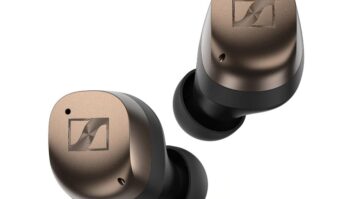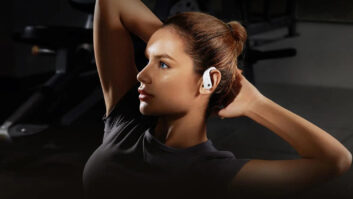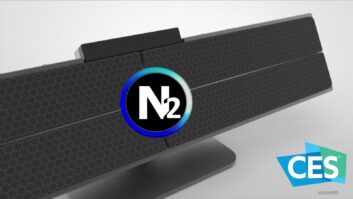LAS VEGAS – Consumer awareness of high-resolution audio (HRA) is in its infancy but slowly catching on, supporters said.
To position themselves for future growth, audio suppliers at International CES are expanding their lines of HRA products, and download sites are expanding their catalogs.
At International CES, dealers will find a slew of new high-res component DACs for the home at prices up to and exceeding $3,000, more components such as integrated amplifiers with USB audio inputs and high-res decoding, and plenty of new portable USB headphone- amp/DACs with high-resolution capabilities priced from $69 to $2,500 or more.
New products include an expanded line of portable products from Sony, which is also launching an in-dash aftermarket head units with high-res decoding and DACs.
As the hardware selection grows, so does the selection of HRA-format music from download sites. Acoustic Sounds’ Super HiREZ Service, for example, expanded its high-res album selection from 2,351 last November to 3,000 in January 2015.
ProStudioMasters.com is expanding this month to 23,500 individual highres songs from 21,000 in November, with the number of albums growing to 1,900 from 1,650.
All told, about 5,000 albums worldwide are available as high-res downloads, with about 30 to 50 albums transferred to high-res formats per week, one musicindustry executive said.
“You know what they say: Slow and steady wins the race, and that’s what is going in terms of market growth for hi-res digital downloads,” said Chas Kassem, founder/ CEO of Acoustic Sounds’ SuperHiRez service. “The majors all have provided us with great catalog titles, but I think over the next year, we’d like to see some of the newer artists become available in high-res. That will create market expansion.”
“All of the labels have done a great job of getting catalog titles to us as 24-bit files,” he continued. “We get content regularly, and we’re adding multiple titles to the site daily. But, like I’ve said, we’re also interested in contemporary content, and that’s been tougher to come by with any regularity. The same goes for DSD files. We’d like to get more of them faster, and we think the market can support and justify the effort and expense of the labels creating those masters.”
Kassem sees the business beginning to attract a “younger, more diverse audience,” although he said “it’s taking longer than we expected. As an industry, we need to make a conscious, collaborative effort to expose younger audiences to hi-res music. Once they hear it, they’ll want it.”
“I think 2015 is the year we need to start expanding our [marketing] focus and start going after music lovers rather than just the audiophile community,” Kassem concluded.
Chris Walker, Pioneer’s director of A/V product planning and marketing, pointed out that “every audio manufacturer has created high-resolution file playback capability components for several years,” but 2014 was “the first year audio manufacturers decided to use the same high-resolution logo and promote these products and high-resolution playback more than previous years.” HRA “will be in greater demand moving forward,” he said.
To meet that demands, suppliers are serving up the following high-res products:
Auralic: The company added Wi-Fi streaming of DSD 256 (quad-DSD) music files from a PC or NAS drive to its $999 Aries streaming bridge, which already streams 2.8MHz DSD (64), 5.6MHz double-rate DSD (128), and Digital eXtreme Definition (DXD) over 802.11 ac Wi-Fi networks.
The company claimed it’s the first to offer DSD 256 streaming over Wi-Fi.
The addition of DSD256 streaming follows Auralic’s recent addition of the CD-quality Tidal streaming service to the Aries. USB playback was also recently added.
Via the Lightning app, users browse their music library, select songs and choose hardware settings. The app, which also features built-in Cloud-based music services such as Spotify, is available for Apple iOS and Android mobile devices, Windows PCs, Mac OS X and Linux OS.
Aries uses a USB Host output to output 2.8MHz DSD (64), 5.6MHz double-rate DSD (128), and DXD in a bit-perfect way to a USB-equipped DAC. To a DAC, the Aries’ USB output also sends PCM in sampling rates from 44.1kHz to 384kHz at 16-, 24- and 32-bit resolutions.
Also via USB, the bridge outputs such audio formats as AAC, AIFF, ALAC, APE, DIFF, DSF, FLAC, MP3, OGG, WAV, WV and WMA
Aries also comes with legacy digital audio outputs such as AES/EBU, coax, and Toslink.
Aurender: The South Korean company, known for high-resolution music servers, is unveiling its $1,295-suggested Flow headphone amp/DAC and $399 Cast-Fi 7.
Cast-Fi 7 is a tabletop stereo speaker with 7-inch color LCD screen to display video from such HDMI sources as the Chromecast, Roku & Amazon Fire TV dongles and from Apple TV, and Blu-ray players.
The 8.3-pound Cast-Fi 7 features resonance-free aluminum enclosure that measures 8.9 inches by 7.1 inches by 5.5 inches and includes a handle, 24-watt amplifier, DAC, HDMI input, and two-way speakers consisting of biamped 1-inch tweeters and 3-inch woofers. An included IR remote controls volume, brightness and sleep timer.
TheFlow features 32-bit/384kHz, DSD 64/128 DAC, USB 3.0 and SPDIF optical inputs, and 6.35 phi standard headphone jack. The DAC/amp is housed in a curved satin-aluminum case with LCD status display, velocity-sensitive volume control dial, and menu, up/ down, play/pause and on/off controls. It weighs less than 1 pound.
The Flow optionally stores up to 1TB of music via a user-installable mSATA slot, turning it into a portable music player with more than 7-hour battery life.
It measures 3.1 inches by 5.4 inches by 1.1 inches and accepts 192/24 PCM via optical input, 384/32 PCM via USB 3.0, and DSD64/128 via USB 3.0.
Bryston: The company’s highest resolution DAC to date is the $3,195-suggested BDA-3, which natively decodes up to 384kHz/32-bit PCM and up to DSDx4 music.
The DAC, expected to ship in the first quarter, connects to almost any source via 10 inputs, including four HDMI inputs, two asynchronous USB inputs, and S/ PDIF over BNC, RCA and Toslink inputs. It has one HDMI output.
Computer-based music players and other digital sources can pass up to DSD-512 and 384/32 PCM to the DAC’s asynchronous USB inputs and up to 192/24 PCM and SACD to the DAC’s HDMI inputs, the company said. (The company said no sources yet output DSD-512 but is getting ready for them). PCM audio up to 192kHz/24 bit can also be sent to the DAC via the DAC’s AES/EBU, Toslink and S/PDIF inputs. Each format is processed in its native resolution to preserve bitperfect signals all the way to the analog output section, Bryston said.
People without the space for a multi-channel home theater system can connect Blu-ray players to the BDA- 3 to deliver high-quality two-channel PCM playback.
The component also upgrades the sound quality of an existing SACD player’s sound quality when connected via HDMI. Players with HDMI outputs to the DAC will deliver “never-before heard detail, space and resolution,” the company said.
Chord Electronics: The $2,495 Hugo headphone amp/DAC, distributed by Bluebird Music, features 384kHz PCM and DSD128 (DXD) playback and proprietary FPGA technology to deliver “analog-like sound quality,” Bluebird said.
It can be used as a selfcontained potable DAC/amp via NiCad rechargeable batteries, which last up to nine hours, or as a home component. Five digital inputs include driverless Micro USB, Micro USB, optical, coaxial and Bluetooth with aptX. Outputs consist of two mini-jack headphone outputs, one quarter-inch headphone output, and one set of RCA phono outputs for playback through a home hi-fi system. The digital volume control does not lose bits, the company said.
Hugo drives high-end headphones and is built from precision-machined aircraft-grade aluminum with a black or silver hard-anodized finish. It’s available.
High Resolution Technologies (HRT): The company is introducing its nano series of compact digital sound processors to improve the resolution, spatiality, dynamics and realism of music played from smartphones, tablets, laptops, and portable devices.
The $69-suggested HRT dSp connects to Android devices and PCs, and the $69 i-dSp works with Lightning connector-equipped Apple products, including the iPhone 5 and 6, iPod touch and current iPad models. Both ultra-compact models incorporate proprietary digital Sound processing and a high-performance headphone amplifier. They ship in January.
The dSp and i-dSp are compatible with audio formats including high-resolution 96kHz/24-bit files.
The dSp’s UAC (USB Audio Class) interface receives USB audio (PCM) from the host device, including from Android devices running the latest Android 5.0 (Lollipop) OS, which offers native support for USB audio via accessories such as the dSp, said CTO Kevin Halverson. The dSP supports all USB Audio Class 1.0 sample rates and bit depths including up to 96 kHz and up to 24 bits.
“Earlier versions of Android OS did not have native USB audio-device support, but some third-party media players added this capability, and some devices included their own USB host stack (required to support a USB audio device),” Halverson noted.
The i-dSP receives PCM from a Lightning-connected Apple mobile device.
Both support such formats as MP3, AAC, FLAC, PCM, Apple and Windows lossless as well as streaming audio and video formats. Both are firmware-upgradeable to accommodate future updates.
Krell: The company is upgrading its Digital Vanguard integrated stereo amplifier with Class A preamplifier and 200-watt amplification to add a digital module that includes USB input, HDMI inputs and output, coax and optical digital inputs, Ethernet music streaming controlled from iOS and Android apps, and apt-X Bluetooth. It will be the company’s first integrated amp with these features.
The upgraded integrated amp will also come with Deezer and vTuner streaming services, and in early 2015, a software update will add Pandora and Spotify apps.
Via USB and home network, the Vanguard streams and decodes MP3, AAC, WMA, WAV (PCM), FLAC and ALAC filed up to 192kHz/24-bit resolution. The coaxial and HDMI inputs support PCM up to 24-bit/192kHz, and the optical input accepts up to 24-bit/96kHz PCM.
The updated Vanguard ships in the first quarter at a price that was unavailable. The existing Vanguard will remain in the line at a suggested $4,500. Owners of the current Vanguard will be able to get field upgrades to add the new board in the first quarter.
Lindemann Audio: The high-end company will make its U.S. debut through importer Bluebird Music of Toronto. Products include two Musicbook USB DACs at $4,495 and $4,995 with 678kHz/24-bit playback resolution and playback of DSD and DSD 256 files. Two network music players are priced at $5,495 and $6,295, the latter with CD drive. Matching two-channel amps are priced at $3,195 and $4,795.
Meridian: A second-generation portable USB DAC, the $299-suggested Explorer 2, features more powerful DSP to improve the sound quality of music stored on laptops and played through headphones or home hi-fi systems.
Like its predecessor, the device streams USB audio up to 192kHz/24-bit quality, but now the device also upsamples all input signals to 176.4/192kHz (or 4x standard sample rates). Thanks to the enhanced DSP, the Explorer 2 also ensures that lossless audio files made from Master Quality Authenticated (MQA) studio masters, approved by the artist and producer, sound like the production team intended, Meridian said.
The device, which just became available, features a headphone output and an analog line output to a home hi-fi system. The device automatically deactivates its headphone amplifier when the line output is connected, thus reducing noise. The 3.5mm headphone socket delivers up to 130mW audio to drive low-efficiency headphones. The second 3.5mm socket provides a fixed-level analogue (2-volt RMS) output. Volume is controlled from the host computer.
Though USB audio is supported on some Android devices, the Explorer 2 might not work with those devices. Explorer 2 “requires both audio and power from the connected USB source, so we cannot guarantee compatibility because we do not know if the Android device can or will provide the needed 5 volts required to power Explorer2 over USB,” a spokesman said.













